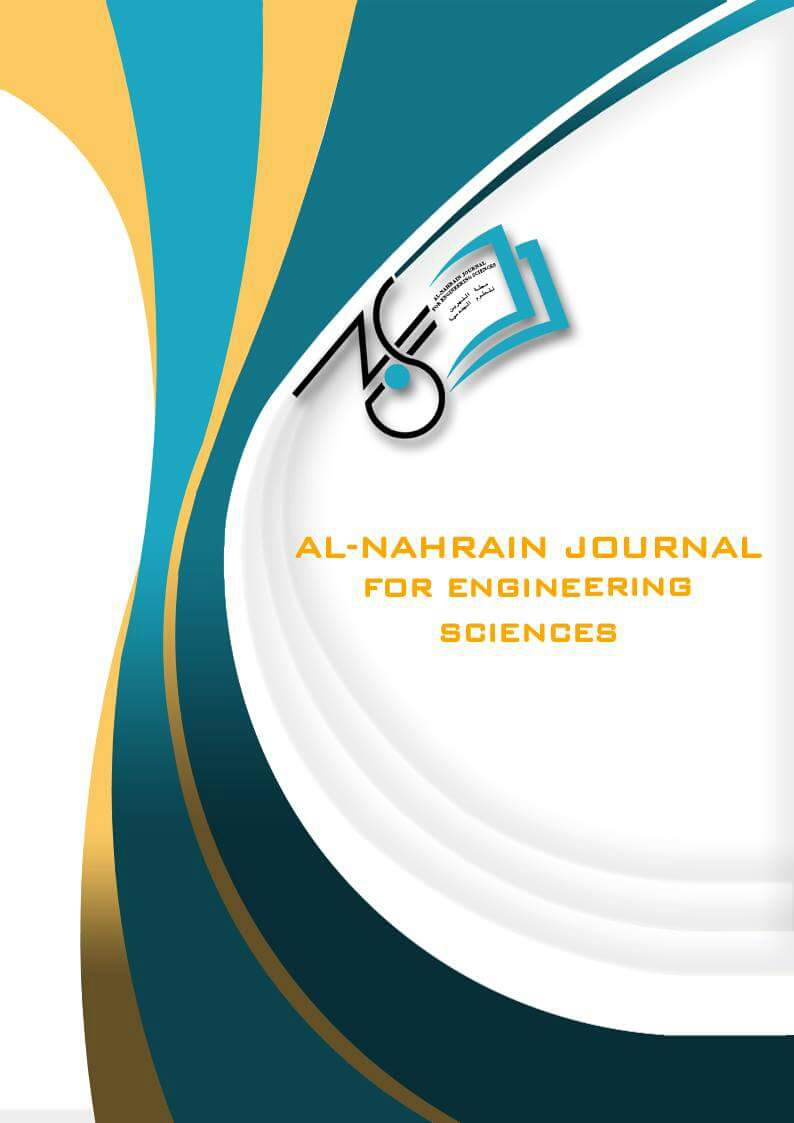Detection of Oil Mineral Pollution in Tigris River from Aldora Refined using Absorbance Spectroscopy
DOI:
https://doi.org/10.29194/NJES.27030346Keywords:
Mineral Oil Detection, Contamination, UV-Vis Absorption Spectroscopy, WastewaterAbstract
Accurately identifying the kind and amount of dissolved metal salts in wastewater used in oil refining processes is an iconic feature of ultraviolet and visible absorption spectroscopy. This method relies on the dissolved metal salts' ability to absorb light at certain wavelengths after reacting with it. The experiments were conducted in a lab setting with a broadband source (200-800 nm) to measure the absorbance of dissolved element salts and precisely identify the lowest concentration up to 2 ppm. A mixture of the mineral salts from oil refining operations was prepared and diluted to different concentrations using a standard solution. This allowed us to study and compare this result with the absorbance behavior of the wastewater from the Al-Dora Refinery. The two results reinforced that we can accurately estimate the detection parameters for the lowest water contamination. These materials are lead nitrate (PbNO3), phenol, calcium carbonate (CaCO3), sodium chloride (NaCl2), sulfide (SO4), and nitrate (NO3). At wavelengths of 340, 404, and 741 nm, the concentrations (10, 20, 30, 40, 50, 60, 70, 80, 90, and 100) ppm were found, and for the concentration of 10ppm, the absorbance (0.15323, 0.15326, and 0.14685) was found, respectively. The process that has been tested with varying concentrations is considered and simulates the variation in river water concentrations caused by the river's water level and flow rate changes by the effect of rain abundance and thawing. It is fast, accurate data analysis, and a lower cost compared with the other chemical analysis and conventional methods.
Downloads
References
F. A. Abdulkareem, T. A. Hussain, and A. A. Najaf, “The Treatment of Wastewater Produced from Al-Doura Refinery to Increase Production and Minimize Pollutant Materials,” Iraqi J. Sci., vol. 62, no. 11, pp. 3984–3996, 2021, doi: 10.24996/ijs.2021.62.11.19. DOI: https://doi.org/10.24996/ijs.2021.62.11.19
C. J. Ugboma, R. R. Nrior, and M. E. Igbudu, “Bioremediation Potential of Algae (Chlorella vulgaris) in Crude Oil Contaminated Sediment,” South Asian J. Res. Microbiol., vol. 15, no. 3, pp. 30–46, 2023, doi:10.9734/sajrm/2023/v15i3289. DOI: https://doi.org/10.9734/sajrm/2023/v15i3289
P. Azik, “A Review of International Conventions Regarding the Responsibilities Caused By Oil Pollution of the Seas,” Isag. - J. Humanit. Soc. Sci., vol. 3, no. 1, pp. 273–287, 2023, doi: 10.59079/isagoge.v3i1.212. DOI: https://doi.org/10.59079/isagoge.v3i1.212
R. Krakowski, “Influence of Effective Microorganisms, Colloidal Nanosilver and Silver Compounds on Water Content in New and Used Engine Oil: A Preliminary Study,” Appl. Sci., vol. 12, no. 20, 2022, doi:10.3390/app122010234. DOI: https://doi.org/10.3390/app122010234
S. N. Zulkifli, H. A. Rahim, and W. J. Lau, “Detection of contaminants in water supply: A review on state-of-the-art monitoring technologies and their applications,” Sensors Actuators, B Chem., vol. 255, pp. 2657–2689, 2018, doi:10.1016/j.snb.2017.09.078. DOI: https://doi.org/10.1016/j.snb.2017.09.078
P. Singh, M. K. Singh, Y. R. Beg, and G. R. Nishad, “A review on spectroscopic methods for determination of nitrite and nitrate in environmental samples,” Talanta, vol. 191, pp. 364–381, 2019. DOI: https://doi.org/10.1016/j.talanta.2018.08.028
D. Li, X. Xu, Z. Li, T. Wang, and C. Wang, “Detection methods of ammonia nitrogen in water: A review,” TrAC Trends Anal. Chem., vol. 127, p. 115890, 2020. DOI: https://doi.org/10.1016/j.trac.2020.115890
R. Karoui, “Spectroscopic technique: fluorescence and ultraviolet-visible (UV-Vis) spectroscopies,” in Modern techniques for food authentication, Elsevier, 2018, pp. 219–252. DOI: https://doi.org/10.1016/B978-0-12-814264-6.00007-4
R. Li, S. Zhang, R. Li, W. Bai, and L. Wang, “Experimental Study on Mechanical Behaviors of Loess Based on Two Different Modes of Oil Contamination,” Geofluids, vol. 2022, 2022, doi: 10.1155/2022/6411520. DOI: https://doi.org/10.1155/2022/6411520
S. Damiani, M. T. Leite Montalvão, R. de Alcântara Mendes, A. C. Gomes da Costa, and C. J. Sousa Passos, “Water and sediment pesticide contamination on indigenous lands surrounded by oil palm plantations in the Brazilian Amazon,” Heliyon, vol. 9, no. 10, 2023, doi: 10.1016/j.heliyon.2023.e19920. DOI: https://doi.org/10.1016/j.heliyon.2023.e19920
J. W. Short and J. M. Maselko, “A Quantitative Comparison of Oil Sources on Shorelines of Prince William Sound, Alaska, 17 Years After the Exxon Valdez Oil Spill,” Arch. Environ. Contam. Toxicol., vol. 85, no. 2, pp. 140–146, 2023, doi: 10.1007/s00244-023-01019-9. DOI: https://doi.org/10.1007/s00244-023-01019-9
A. M. Pasqualeti et al., “Sensors for detection of production chemicals and oil in produced water,” TrAC - Trends Anal. Chem., vol. 168, no. August, 2023, doi: 10.1016/j.trac.2023.117305. DOI: https://doi.org/10.1016/j.trac.2023.117305
N. Abdullahi et al., “Nigerian Palm Oil: Quality Disparity, Contamination and Processing Wastes Handling,” Fudma J. Sci., vol. 7, no. 1, pp. 126–135, 2023, doi: 10.33003/fjs-2023-0701-1263. DOI: https://doi.org/10.33003/fjs-2023-0701-1263
I. A. Amar, S. I. Faraj, M. A. Abdulqadir, I. A. Abdalsamed, F. A. Altohami, and M. A. Samba, “Oil spill removal from water surfaces using zinc ferrite magnetic nanoparticles as a sorbent material,” Iraqi J. Sci., vol. 62, no. 3, pp. 718–728, 2021, doi: 10.24996/ijs.2021.62.3.2. DOI: https://doi.org/10.24996/ijs.2021.62.3.2
M. M. Shellal, N. M. Hadi, and T. M. Mohammed, “Design and Construction of Differential Optical Absorption Spectroscopy (DOAS) System for NOx Remote Sensing,” Eng. Technol. J., vol. 34, no. Issue 5 A, pp. 839–846, 2016, doi: 10.30684/etj.34.5a.3. DOI: https://doi.org/10.30684/etj.34.5A.3
Downloads
Published
Issue
Section
License
Copyright (c) 2024 Thamer Mahmood Mohammed, Ahmed K. Ahmed

This work is licensed under a Creative Commons Attribution-NonCommercial 4.0 International License.
The authors retain the copyright of their manuscript by submitting the work to this journal, and all open access articles are distributed under the terms of the Creative Commons Attribution-NonCommercial 4.0 International (CC-BY-NC 4.0), which permits use for any non-commercial purpose, distribution, and reproduction in any medium, provided that the original work is properly cited.














